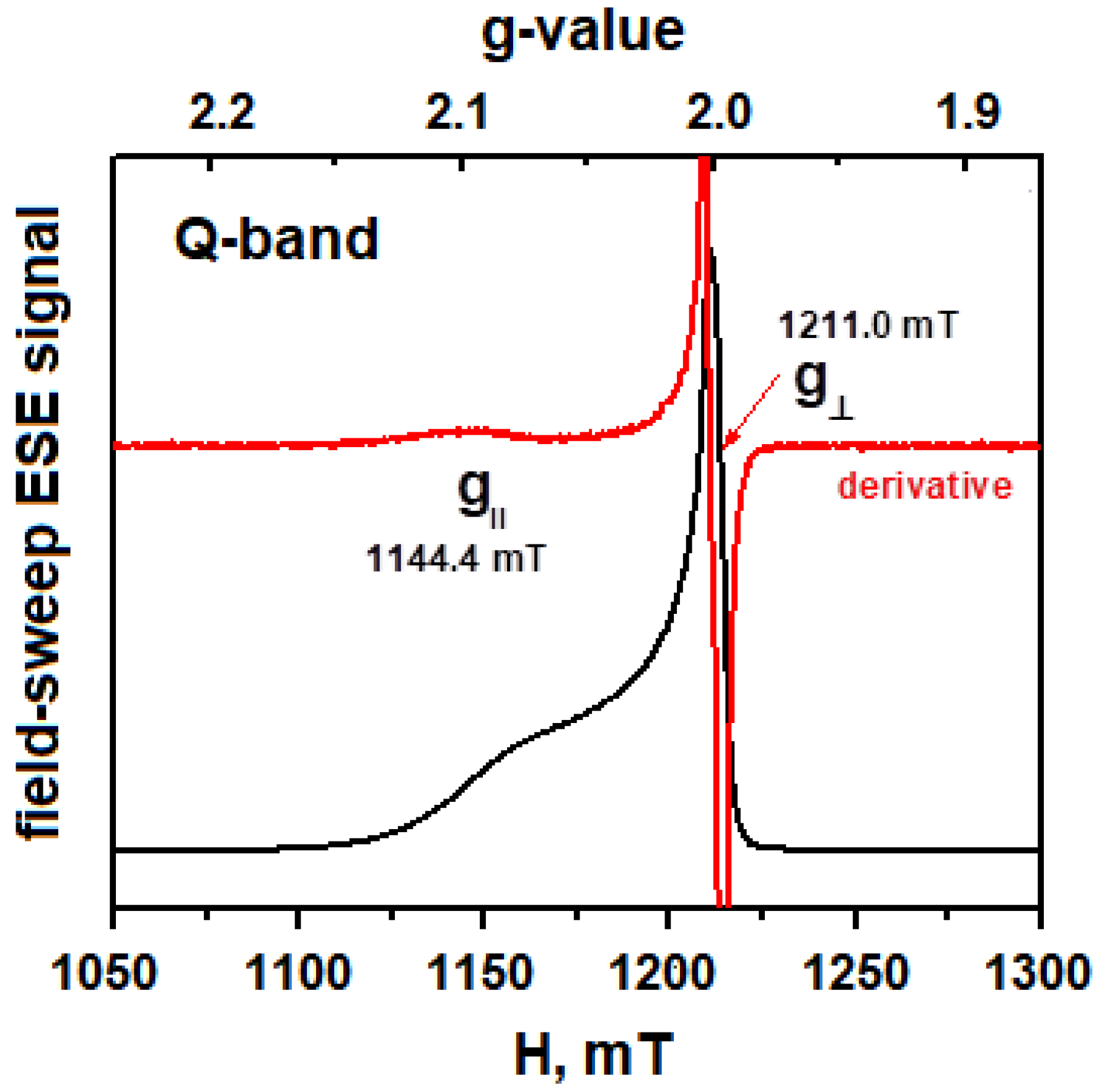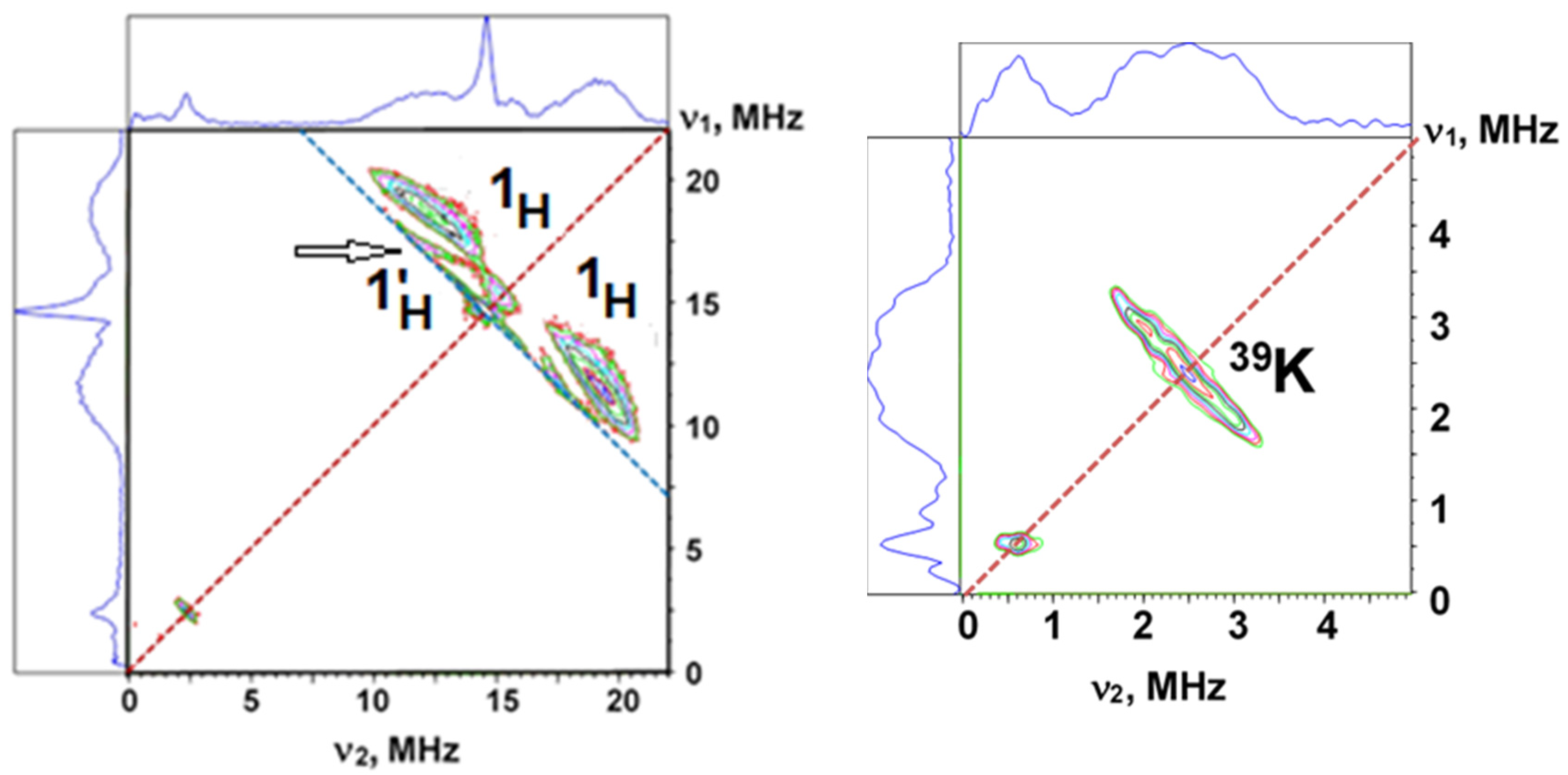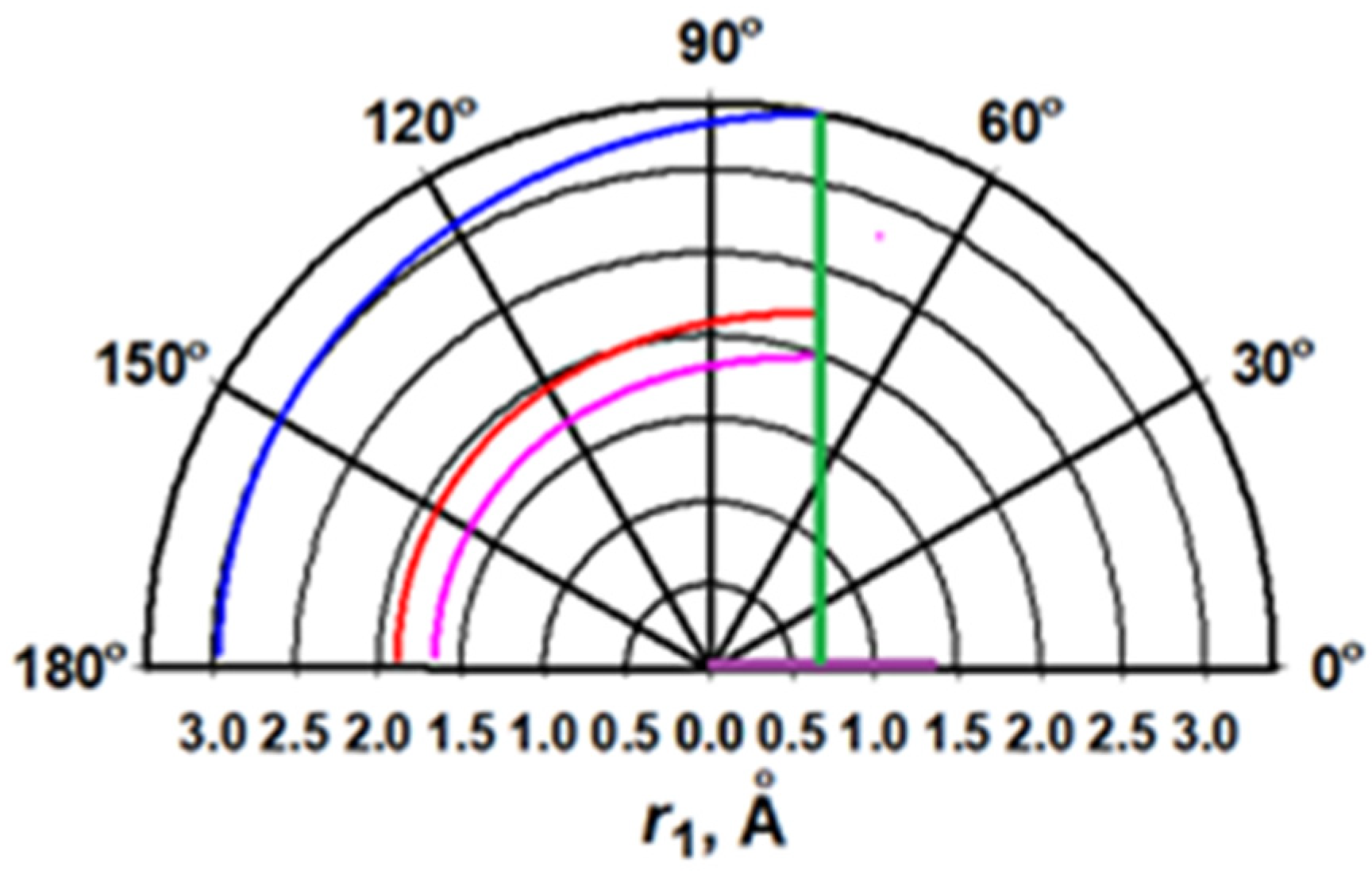Superoxide Radical Formed on the TiO2 Surface Produced from Ti(OiPr)4 Exposed to H2O2/KOH
Abstract
1. Introduction
2. Materials and Methods
2.1. Preparation of the Catalysts
2.2. EPR Measurements
3. Results and Discussions
3.1. EPR Spectra of Dried TiO2 + H2O2
3.2. EPR Spectra in the Presence of KOH
3.3. Pulsed EPR Characterization of the Radical
4. Discussions
4.1. Analysis of the 1H HYSCORE Spectra
4.2. Evaluation of the Proton Anisotropic Hyperfine Couplings
4.3. Interaction with 39K Nucleus
4.4. Comparison with Superoxide on a Na or Cs Pre-Covered MgO Surface
5. Conclusions
Supplementary Materials
Author Contributions
Funding
Institutional Review Board Statement
Informed Consent Statement
Data Availability Statement
Acknowledgments
Conflicts of Interest
References
- Hayyan, M.; Hashim, M.A.; AlNashef, I.M. Superoxide Ion: Generation and Chemical Implications. Chem. Rev. 2016, 116, 3029–3085. [Google Scholar] [CrossRef]
- Afanas’ev, I.B. The Oxygen Radical-anion O2− in Chemical and Biochemical Processes. Russ. Chem. Rev. 1979, 48, 527–549. [Google Scholar] [CrossRef]
- Sawyer, D.T.; Valentine, J.S. How Super Is Superoxide? Acc. Chem. Res. 1981, 14, 393–400. [Google Scholar] [CrossRef]
- Anpo, M.; Che, M.; Fubini, B.; Garrone, E.; Giamello, E.; Paganini, M.C. Generation of Superoxide Ions at Oxide Surfaces. Top. Catal. 1999, 8, 189–198. [Google Scholar] [CrossRef]
- Che, M.; Tench, A.J. Characterization and Reactivity of Molecular Oxygen Species on Oxide Surfaces. Adv. Catal. 1983, 32, 1–148. [Google Scholar]
- Kokorin, A.I. Electron Spin Resonance of Nanostructured oxide semiconductors. In Chemical Physics of Nanostructured Semiconductors; Kokorin, A.I., Bahnemann, D.W., Eds.; CRC Press: Boca Raton, FL, USA, 2003; Chapter 8; pp. 203–263. [Google Scholar]
- Chiesa, M.; Giamello, E.; Che, M. EPR Characterization and Reactivity of Surface-Localized Inorganic Radicals and Radical Ions. Chem. Rev. 2010, 110, 1320–1347. [Google Scholar] [CrossRef]
- Sobańska, K.; Krasowska, A.; Mazur, T.; Podolska-Serafin, K.; Pietrzyk, P.; Sojka, Z. Diagnostic Features of EPR Spectra of Superoxide Intermediates on Catalytic Surfaces and Molecular Interpretation of Their g and A Tensors. Top. Catal. 2015, 58, 796–810. [Google Scholar] [CrossRef]
- Giamello, E.; Rumori, P.; Geobaldo, F.; Fubini, B.; Paganini, M.C. The Interaction between Hydrogen Peroxide and Metal Oxides: EPR Investigations. Appl. Magn. Res. 1996, 10, 173–192. [Google Scholar] [CrossRef]
- Dewkar, G.K.; Nikalje, M.D.; Sayyed, I.A.; Paraskar, A.S.; Jagtap, H.S.; Sudalai, A. An Exceptionally Stable Ti Superoxide Radical Ion: A Novel Heterogeneous Catalyst for the Direct Conversion of Aromatic Primary Amines to Nitro Compounds. Angew. Chem. Int. Ed. 2001, 40, 405–408. [Google Scholar] [CrossRef]
- Dewkar, G.K.; Shaikh, T.M.; Pardhy, S.; Kulkarni, S.S.; Sudalai, A. Titanium superoxide catalyzed selective oxidation of phenols to p-quinones with aq. H2O2. Indian J. Chem. B 2005, 44, 1530–1532. [Google Scholar] [CrossRef]
- Reddy, R.S.; Shaikh, T.M.; Rawat, V.; Karabal, P.U.; Dewkar, G.; Suryavanshi, G.; Sudalai, A. A Novel Synthesis and Characterization of Titanium Superoxide and its Application in Organic Oxidative Processes. Catal. Surv. Asia 2010, 14, 21–32. [Google Scholar] [CrossRef]
- Samoilova, R.I.; Dikanov, S.A. Local environment of superoxide radical formed on the TiO2 surface produced from Ti(OiPr)4 exposed to H2O2. Appl. Magn. Reson. 2022, 53, 1089–1104. [Google Scholar] [CrossRef]
- Jin, F.; Leitich, J.; von Sonntag, C. The superoxide radical reacts with tyrosine-derived phenoxyl radicals by addition rather than by electron transfer. J. Chem. Soc. Perkin. Trans. II 1993, 1583–1588. [Google Scholar] [CrossRef]
- Schunemann, V.; Lendzian, F.; Jung, C.; Contzen, J.; Barra, A.-L.; Sligar, S.G.; Trautwein, A.X. Tyrosine Radical Formation in the Reaction of Wild Type and Mutant Cytochrome P450cam with Peroxy. J. Biol. Chem. 2004, 279, 10919–10930. [Google Scholar] [CrossRef] [PubMed]
- Hitchcock, D.I. The solubility of tyrosine in acid and alkali. J. Gen. Physiol. 1924, 6, 747–757. [Google Scholar] [CrossRef] [PubMed]
- Höfer, P.; Grupp, A.; Nebenführ, H.; Mehring, M. Hyperfine Sublevel Correlation (HYSCORE) spectroscopy: A 2D ESR investigation of the squaric acid radical. Chem. Phys. Lett. 1986, 132, 279–282. [Google Scholar] [CrossRef]
- Davies, E.R. A New Pulse Endor Technique. Phys. Lett. A 1974, 47, 1–2. [Google Scholar] [CrossRef]
- Lunsford, J.H. ESR of Adsorbed Oxygen Species. Catal. Rev. 1973, 8, 135–157. [Google Scholar] [CrossRef]
- Symons, M.C.R.; Eastland, G.W.; Denny, L.R. Effect of Solvation on the Electron Spin Resonance Spectrum of the Superoxide ion. J. Chem. Soc. Faraday Trans. I 1980, 76, 1868–1874. [Google Scholar] [CrossRef]
- Narayana, P.A.; Suryanarayana, D.; Kevan, L. Electron Spin-Echo Studies of the Solvation Structure of Superoxide ion (O2−) in Water. J. Am. Chem. Soc. 1982, 104, 3552–3555. [Google Scholar] [CrossRef]
- Samoilova, R.I.; Crofts, A.R.; Dikanov, S.A. Reaction of Superoxide Radical with Quinone Molecules. J. Phys. Chem. A 2011, 115, 11589–11593. [Google Scholar] [CrossRef]
- Haseloff, R.; Ebert, B.; Damerau, W. Superoxide generation in alkaline dimethyl sulfoxide. Anal. Chim. Acta. 1989, 218, 179–184. [Google Scholar] [CrossRef]
- Krager, K. Superoxide in Aprotic Solvents; The University of Iowa: Iowa City, IA, USA, 2003. [Google Scholar]
- Hyland, K.; Auclair, C. The Formation of Superoxide Radical Anions by a Reaction Between O2, OH− and Dimethyl Sulfoxide. Biochem. Biophys. Res. Comm. 1981, 102, 531–537. [Google Scholar] [CrossRef] [PubMed]
- Dikanov, S.A.; Bowman, M.K. Cross-peak lineshape of two-dimensional ESEEM spectra in disordered S=1/2, I=1/2 spin system. J. Magn. Reson., Ser. A 1995, 116, 125–128. [Google Scholar] [CrossRef]
- Napoli, F.; Chiesa, M.; Giamello, E.; Preda, G.; Di Valentin, C.; Pacchioni, G. Formation of Superoxo Species by Interaction of O2 with Na Atoms Deposited on MgO Powders: A Combined Continuous-Wave EPR (CW-EPR), Hyperfine Sublevel Correlation (HYSCORE) and DFT Study. Chem. Eur. J. 2010, 16, 6776–6785. [Google Scholar] [CrossRef]
- Randall, D.W.; Gelasco, A.; Caudle, M.T.; Pecoraro, V.L.; Britt, R.D. ESE-ENDOR and ESEEM Characterization of Water and Methanol Ligation to a Dinuclear Mn(III)Mn(IV) Complex. J. Am. Chem. Soc. 1997, 119, 4481–4491. [Google Scholar] [CrossRef]
- Janik, I.; Tripathi, G.N.R. The nature of the superoxide radical anion in water. J. Chem. Phys. 2013, 139, 014302. [Google Scholar] [CrossRef] [PubMed]
- Chiesa, M.; Giamello, E.; Paganini, M.C.; Sojka, Z.; Murphy, D.M. Continuous Wave Electron Paramagnetic Resonance Investigation of the Hyperfine Structure of 17O2− Adsorbed on the MgO Surface. J. Chem. Phys. 2002, 116, 4266–4274. [Google Scholar] [CrossRef]
- Maurelli, S.; Vishnuvarthan, M.; Berlier, G.; Chiesa, M. NH3 and O2 interaction with tetrahedral Ti3+ ions isomorphously substituted in the framework of TiAlPO-5. A combined pulse EPR, pulse ENDOR, UV-Vis and FT-IR study. Phys. Chem. Chem. Phys. 2012, 14, 987–995. [Google Scholar] [CrossRef] [PubMed]
- Dietzel, P.D.C.; Kremer, R.K.; Jansen, M. Tetraorganylammonium Superoxide Compounds: Close to Unperturbed Superoxide Ions in the Solid State. J. Am. Chem. Soc. 2004, 126, 4689–4696. [Google Scholar] [CrossRef]
- Seyeda, H.; Jansen, M. A novel access to ionic superoxides and the first accurate determination of the bond distance in O2−. J. Chem. Soc. Dalton Trans. 1998, 6, 875–876. [Google Scholar] [CrossRef]
- Halverson, F. Comments on Potassium Superoxide Structure. J. Phys. Chem. Solids 1962, 23, 207–214. [Google Scholar] [CrossRef]
- Antonchenko, V.Y.; Kryachko, E.S. Interaction of Superoxide O2− with Water Hexamer Clusters. Chem. Phys. 2006, 327, 485–493. [Google Scholar] [CrossRef]
- Antonchenko, V.Y.; Kryachko, E.S. Structural, Energetic, and Spectroscopic Features of Lower Energy Complexes of Superoxide Hydrates O2−(H2O)1-4. J. Phys. Chem. A 2005, 109, 3052–3059. [Google Scholar] [CrossRef] [PubMed]
- Barkhuijsen, H.; de Beer, R.; Deutz, A.F.; van Ormondt, D.; Völkel, G. Observation of Potassium Hyperfine Interactions in X-irradiated KH2AsO4 through the Method of Electron Spin Echo Envelope Modulation. Solid State Commun. 1984, 49, 679–684. [Google Scholar] [CrossRef]
- Nellutla, S.; Morley, G.W.; van Tol, J.; Pati, M.; Dalal, N.S. Electron Spin Relaxation and 39K Pulsed ENDOR Studies on Cr5+-doped K3NbO8 at 9.7 and 240 GHz. Phys. Rev. B 2008, 78, 054426. [Google Scholar] [CrossRef]
- Gutjahr, M.; Böttcher, R.; Pöppl, A. Analysis of Correlation Patterns in Hyperfine Sublevel Correlation Spectroscopy of S = 1/2, I = 3/2 Systems. Appl. Magn. Reson. 2002, 22, 401–414. [Google Scholar] [CrossRef]
- Abrahams, S.C.; Kalnajs, J. The Crystal Structure of α-Potassium Superoxide. Acta Crystallogr. 1955, 8, 503–506. [Google Scholar] [CrossRef]
- Carter, G.F.; Templeton, D.H. Polymorphism of Sodium Superoxide. J. Am. Chem. Soc. 1953, 75, 5247–5249. [Google Scholar] [CrossRef]
- Deng, N.; Yang, G.; Wang, W.; Qiu, Y. Structural Transitions and Electronic Properties of Sodium Superoxide at High Pressures. RSC Adv. 2016, 6, 67910–67915. [Google Scholar] [CrossRef]
- Smardzewski, R.R.; Andrews, L. Raman Spectra of the Products of Na and K Atom Argon Matrix Reactions with O2 Molecules. J. Chem. Phys. 1972, 57, 1327–1333. [Google Scholar] [CrossRef]
- Morton, J.R.; Preston, K.F. Atomic Parameters for Paramagnetic Resonance Data. J. Magn. Reson. 1978, 30, 577–583. [Google Scholar] [CrossRef]
- Giamello, E.; Ugliengo, P.; Garrone, E.; Che, M.; Tench, A.J. Experimental Evidence for the Hyperfine Interaction between a Surface Superoxide Species on MgO and a Neighbouring Hydroxylic Proton. J. Chem. Soc. Faraday Trans. I 1989, 85, 3987–3994. [Google Scholar] [CrossRef]
- Lindsay, D.M.; Herschbach, D.R.; Kwiram, A.L. ESR of Matrix Isolated Alkali Superoxides. Chem. Phys. Lett. 1974, 25, 175–181. [Google Scholar] [CrossRef]
- Chiesa, M.; Paganini, M.C.; Giamello, E.; Murphy, D.M. Partial Ionization of Cesium Atoms at Point Defects over Polycrystalline Magnesium Oxide. J. Phys. Chem. B 2001, 105, 10457–10460. [Google Scholar] [CrossRef]
- Antcliff, K.L.; Murphy, D.M.; Griffithsa, E.; Giamello, E. The interaction of H2O2 with exchanged titanium oxide systems (TS-1, TiO2, [Ti]-APO-5, Ti-ZSM-5). Phys. Chem. Chem. Phys. 2003, 5, 4306–4316. [Google Scholar] [CrossRef]
- Ramaswamy, V.; Awati, P.; Ramaswamy, A.V. Epoxidation of indene and cyclooctene on nanocrystalline anatase titania catalyst. Top. Catal. 2006, 38, 251–259. [Google Scholar] [CrossRef]
- Tengvall, P.; Lundström, I.; Sjöqvist, L.; Elwing, H.; Bjursten, L.M. Titanium-hydrogen peroxide interaction: Model studies of the influence of the inflammatory response on titanium implants. Biomaterials 1989, 10, 166–175. [Google Scholar] [CrossRef]
- Green, J.; Carter, E.; Murphy, D.M. Interaction of molecular oxygen with oxygen vacancies on reduced TiO2: Site specific blocking by probe molecules. Chem. Phys. Lett. 2009, 477, 340–344. [Google Scholar] [CrossRef]
- Carter, E.; Carley, A.F.; Murphy, D.M. Evidence for O2− Radical Stabilization at Surface Oxygen Vacancies on Polycrystalline TiO2. J. Phys. Chem. C 2007, 111, 10630–10638. [Google Scholar] [CrossRef]
- Liu, F.; Feng, N.; Wang, Q.; Xu, J.; Qi, G.; Wang, W.; Deng, F. Transfer Channel of Photoinduced Holes on a TiO2 Surface As Revealed by Solid-State Nuclear Magnetic Resonance and Electron Spin Resonance Spectroscopy. J. Am. Chem. Soc. 2017, 139, 10020–10028. [Google Scholar] [CrossRef] [PubMed]
- Rahemi, V.; Trashin, S.; Hafideddine, Z.; Meynen, V.; Van Doorslaer, S.; De Wael, K. Enzymatic sensor for phenols based on titanium dioxide generating surface confined ROS after treatment with H2O2. Sens. Actuators B Chem. 2019, 283, 343–348. [Google Scholar] [CrossRef]
- Yu, J.; Chen, J.; Li, C.; Wang, X.; Zhang, B.; Ding, H. ESR Signal of Superoxide Radical Anion Adsorbed on TiO2 Generated at Room Temperature. J. Phys. Chem. B 2004, 108, 2781–2783. [Google Scholar] [CrossRef]
- Dikanov, S.A.; Tyryshkin, A.M.; Bowman, M.K. Intensity of cross-peaks in HYSCORE spectra of S = 1/2, I = 1/2 spin systems. J. Magn. Reson. 2000, 144, 228–242. [Google Scholar] [CrossRef] [PubMed]



| Matrix | g||(gzz) | g⊥(gx,y) | Reference |
|---|---|---|---|
| H2O ice (K2O) | 2.110 | [20] | |
| D2O ice (0.1 mM K2O) | 2.110 | 2.002 | [21] |
| KO2 in DMSO/H2O in the presence of ubiquinone-10 | 2.108 | 2.004 | [22] |
| Alkaline DMSO | 2.098 | 2.005 | [23,24] |
| 10 μL of 0.5M NaOH/mL of DMSO | 2.089 | 2.007 | [25] |
| TiO2 + H2O2+ KOH | 2.10 | 2.002 | This work |
| T, MHz | r1 (H–O1), Å | β, Degree | r1 at β = 180°, Å | r1 at β = 120°, Å | References a |
|---|---|---|---|---|---|
| 2 | 2.97–3.4 | 180–75 | 2.97 | 3.08 | [13] |
| 7 | 1.89–2.24 | 180–73 | 1.89 | 1.95 | This work |
| 10 | 1.67–1.99 | 180–70 | 1.67 | 1.71 | [22,27] |
| Sample | gzz | T11 | T22 | T33 | aiso | A0 | ρו10−3 | Ref. a |
|---|---|---|---|---|---|---|---|---|
| 23NaO2 | 2.111 | −2.8 | 1.68 | −1.12 | 9 | 927.1 | 9.7 | [46] |
| O2•− on Na/MgO | 2.14 | −0.1 | 3.1 | −3.0 | −15 | 927.1 | 16.2 | [27] |
| 133CsO2 | 2.107 | −0.56 | 0.84 | −0.28 | 14 | 2464 | 5.7 | [46] |
| O2•− on Cs/MgO | 2.120 | 5.1 | 2.6 | −7.7 | 29.6 | 2464 | 12.0 | [47] |
Disclaimer/Publisher’s Note: The statements, opinions and data contained in all publications are solely those of the individual author(s) and contributor(s) and not of MDPI and/or the editor(s). MDPI and/or the editor(s) disclaim responsibility for any injury to people or property resulting from any ideas, methods, instructions or products referred to in the content. |
© 2023 by the authors. Licensee MDPI, Basel, Switzerland. This article is an open access article distributed under the terms and conditions of the Creative Commons Attribution (CC BY) license (https://creativecommons.org/licenses/by/4.0/).
Share and Cite
Samoilova, R.I.; Dikanov, S.A. Superoxide Radical Formed on the TiO2 Surface Produced from Ti(OiPr)4 Exposed to H2O2/KOH. Inorganics 2023, 11, 274. https://doi.org/10.3390/inorganics11070274
Samoilova RI, Dikanov SA. Superoxide Radical Formed on the TiO2 Surface Produced from Ti(OiPr)4 Exposed to H2O2/KOH. Inorganics. 2023; 11(7):274. https://doi.org/10.3390/inorganics11070274
Chicago/Turabian StyleSamoilova, Rimma I., and Sergei A. Dikanov. 2023. "Superoxide Radical Formed on the TiO2 Surface Produced from Ti(OiPr)4 Exposed to H2O2/KOH" Inorganics 11, no. 7: 274. https://doi.org/10.3390/inorganics11070274
APA StyleSamoilova, R. I., & Dikanov, S. A. (2023). Superoxide Radical Formed on the TiO2 Surface Produced from Ti(OiPr)4 Exposed to H2O2/KOH. Inorganics, 11(7), 274. https://doi.org/10.3390/inorganics11070274











